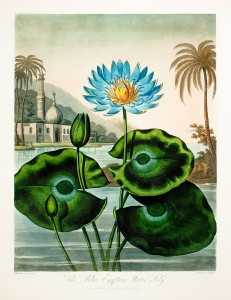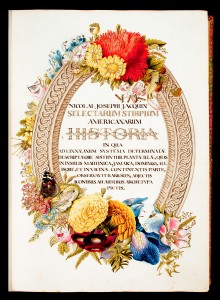New Exhibition Showcases Treasures from Mertz Library
Posted in Exhibitions on November 4 2009, by Plant Talk
 |
Jane Dorfman is Reference Librarian/Exhibitions Coordinator in the LuEsther T. Mertz Library. |
Mertz  Library Director Susan Fraser and Curators Stephen Sinon and I had the delightful task of selecting the 63 items that comprise the latest exhibit in the Library’s Rondina and LoFaro Gallery, Ex Libris: Treasures from the LuEsther T. Mertz Library, on through January 10, 2010. This is a show about the Library’s rich and varied collections. Although delightful, it was not an easy task to select from such a treasure trove of material. The LuEsther T. Mertz Library is the largest botanical and horticultural library under one roof, and this show is but a small sampling of the Library’s rich and varied collections of rare books, original botanical art, and manuscripts.
Library Director Susan Fraser and Curators Stephen Sinon and I had the delightful task of selecting the 63 items that comprise the latest exhibit in the Library’s Rondina and LoFaro Gallery, Ex Libris: Treasures from the LuEsther T. Mertz Library, on through January 10, 2010. This is a show about the Library’s rich and varied collections. Although delightful, it was not an easy task to select from such a treasure trove of material. The LuEsther T. Mertz Library is the largest botanical and horticultural library under one roof, and this show is but a small sampling of the Library’s rich and varied collections of rare books, original botanical art, and manuscripts.
We selected the individual pieces on the basis of our combined knowledge of the collections and on research regarding the unique character of each object and its inherent beauty or distinctiveness, such as the hand-colored and color-printed aquatint engraving shown above, The Blue Egyptian Water-Lily from Temple of Flora, by Robert John Thornton (1768?–1837; London: T. Bensley, 1907), one of the greatest botanical works ever published.
In our selections we also favored those objects that were not shown in our previous exhibits. And we strove to include sumptuous images, so pictures of fruits naturally came to mind. One unusual and beautiful book about fruits (and vegetables) by 19th-century German author Johann Ferdinand Shreiber (fl. 1839), Bilder zum Anschauungs-Unterricht für die Jugend, is actually a children’s book. It was rediscovered by Stephen while he was looking for images to promote the Garden’s summer show, The Edible Garden. He kept the book in mind, and now it’s in the Ex Libris exhibit, displaying luscious grapes and abundant hops.
 One section of the show is devoted to exceptional frontispieces and other front material of rare books, and includes a hand-painted title page depicting a magnificent floral wreath by the celebrated botanical illustrator Franz Bauer (1758–1840; pictured at left). The volume in which it appeared, Selectarum stirpium Americanarum historia, by Nikolaus Joseph Jacquin (1727–1817; Vienna, ca. 1780), is extremely rare, one of only 12 copies in the world.
One section of the show is devoted to exceptional frontispieces and other front material of rare books, and includes a hand-painted title page depicting a magnificent floral wreath by the celebrated botanical illustrator Franz Bauer (1758–1840; pictured at left). The volume in which it appeared, Selectarum stirpium Americanarum historia, by Nikolaus Joseph Jacquin (1727–1817; Vienna, ca. 1780), is extremely rare, one of only 12 copies in the world.
Of the 30,000 pieces of original botanical art in the Library’s collection, we could only display 19, but the ones selected represent world famous artists such as Anne Ophelia Dowden (1907–2007) and Margaret Mee (1909–88), among others. Many of the works on display appeared in publications of New York Botanical Garden scientists. (Some of the images are posted in an online gallery.)
Great floral books, those that are remarkable both for their beauty and scientific accuracy, are also showcased. An image of the Mandragora atropa, the mandrake, from Flora Graeca, by John Sibthorp (1758–96), is on view. Known in ancient times for its magical properties, the mandrake root is believed to resemble Man, and when pulled out of the Earth, screams so horribly that the sound kills anyone who hears it. This myth is alive and well and reflected in the Harry Potter tales. The image on display comes from a work that is considered one of the great botanical books, and the image speaks to adults and children even today.
Botanical exploration, gold stamp bindings, mushrooms, and manuscripts are other themed displays to be enjoyed. I welcome you to come and be dazzled by the rich and luxurious treasures that Ex Libris and the LuEsther T. Mertz Library have to offer.
As well, a special display of original artworks by Auguste Mariolle (b. 1866), the Botanical Garden’s first botanical illustrator and one of the artists featured in Ex Libris, can be viewed in the Library’s Rare Book and Folio Room and Reading Room.
You may view Ex Libris: Treasures from the LuEsther T. Mertz Library on your own or on a guided tour. For tour dates and hours, see Plan Your Visit.

